Recently, I was asked a few questions about gear - "How do you have your setup, what do you carry, etc, etc..." In an effort to consolidate some of this information in one place and give others something to consider, I decided to write some of my thoughts down. I'm not an expert by any means, but I have spent a considerable amount of time thinking about my gear setup, learning about whats available, and through trial and error, deciding what setup works best for me.
A lot of this relates to more of the big game mentality, rather than small local games, but the way I see it, we've moved into a pattern of attending a big game every six months or so, and I find that more or less everything in between is filler for me to figure out what I'm doing wrong so that I don't do it at the big games.
-----
I could categorize my approach to gear as an ideology rather than a specific pattern. I am constantly asking myself "How can I do this faster, lighter, and better?" It comes down to carrying what you need with little to no excess in such a way that it is easy for you to manipulate it and have fun.
I consider everything I carry to be essential to the way I play airsoft. Several times, I've seen people at big games remove some of their gear for the Sunday portion of the game. I've always wondered why they didn't get their stuff squared away before they even showed up. I cannot dump any part of my gear and still function in the way that I'd like to. I don't think anyone really carries stuff they don't use or don't intend to possibly use, but I do think that some people carry stuff that is unlikely to be used.
For example, I used to carry a medical pouch with a snake bite kit, an eye patch, one of those instant cold packs, etc. In retrospect, if I need an eye patch, I probably can't keep playing airsoft that day. Now all I carry is bandaids, electrolytes, aspirin, and the like. Stuff that could deal with problems that would make me more comfortable if something did happen but didn't prevent me from continuing to play airsoft. I also used to have a flashlight, multitool, and compass in my utility pouches, but found that I never used them. Maybe in the future, I'll run across a situation where I decide to carry a multitool and flashlight again.
The key is finding out what works for you. What works for me may not be the same as what you need. Unfortunately, sometimes the process of discovering these things can be time consuming and expensive. Trial and error is really the only sure way. Your gear should work for you, not against you. I find that if everything is working correctly, I don't even think about it. If I keep thinking, "This radio antenna is poking me," that means I need to do something about it so that its not a problem anymore.
I see and hear other people talk about how they're putting up with this or making due with that or fighting with their gear in some fashion. You shouldn't have to do this. You don't have to "make due" or "put up" with anything. We are fortunate to have various people here that can sew up just about anything you could want.
Overall, I think what you carry can be broken down into 3 major categories -
1 - Ammunition (Magazines & Reloading Capability)
2 - Hydration (Water)
3 - Communications (Radio)
-----
Ammunition (Magazines & Reloading) -Number of magazines -Before I really started to think about what I was doing, I carried 13 magazines; 12 in my gear and 1 in the weapon. 12 on my rig seemed like a nice round number that allowed me plenty of mags and at the time, I didn't think it took up too much space or weighed too much. I did not carry any reloading capability.
I began to notice that I rarely ran through even half of those 13 magazines in any given situation. In late 2003, with the introduction of the pistol mag loader, battlefield reloading of standard magazines became a possibility and I started to consider that perhaps I could carry less magazines and some of the loaders. So I decided that instead of carrying 13 magazines, I'd reduce it to 9 mags. 8 in my gear and 1 in my weapon.
I now carry six pistol mag loaders. They each carry about 100 BBs and six of them gives me about 600 additional BBs. So with six loaders, I can reload all my magazines about once. My immediately available ammunition is lower than what I used to carry, (585 vs 845) but my overall capacity is at least doubled by the BBs in my loaders plus whatever additional bag of BBs I'm carrying. I also often carry a bag of extra BBs. 600 extra BBs in a bag takes up very little room. 1200 and 1800 aren't very much room either, so an effective triple or quadruple basic load isn't out of the question. A folded bag with a rubber band on it makes very little noise if stowed properly. Any noise that the pistol mag loaders make is reduced by being inside of my utility pouch.
Mag Pouches -I like dual magazine pouches. Some people like single pouches and some like triple mag pouches as well. I feel that I can go prone, which doesn't happen that often, on a dual stack of M4 magazines with no problem. I prefer mag pouches with velcro closures. I think that gives the best compromise between speed and retention.
I put my magazines into mag pouches with the spine of the magazine to the left. (Sometimes called "Bullets forward") When I grab the magazine with my left hand, it is in the correct position to twist my hand around and insert the magazine with the least amount of movement.
When I draw a magazine, it is always from the same location on the left, unless I'm engaged in an extended firefight where I've gone through several of my magazines with a chance to replenish/replace and top off my magazines.
Reloading Magazines -An emergency reload is reloading your magazine when you have to - it is empty; a tactical reload is a reload when you want to - partially empty. I never used to do any sort of tactical reloads and would just run my mags until they were dry and then reload. I don't do a tactical reload all the time now, and its something I've only recently incorporated into the way I manage my magazines. I mention it here because of the way it affects my gear setup. With the pistol mag loaders, I can now "top off" magazines that I've ditched before they were completely expended.
I try to have a good idea of what I've got in a magazine at any given time, but trying to count rounds is not a good idea. If I can't recall whats in it, I change it out. Next chance I get, I'll be back up to full capacity anyways.
I always try and complete several tasks during any downtime.
1) Drink water.
2) Put a full magazine in my weapon.
3) Move loaded magazines from right side pouches into empty left side pouches. (If necessary)
4) Remove any magazines in my dump pouch and replace them into the right side mag pouches to "go silent" again.
5) Replenish completely empty magazines.
6) Replenish partially empty magazines.
7) Replenish pistol mag loaders with BBs from bag.
Obviously some things take longer than others, and some things may happen in a different order than what I've got here. In theory, if you have enough time, you can reload your entire complement of magazines.
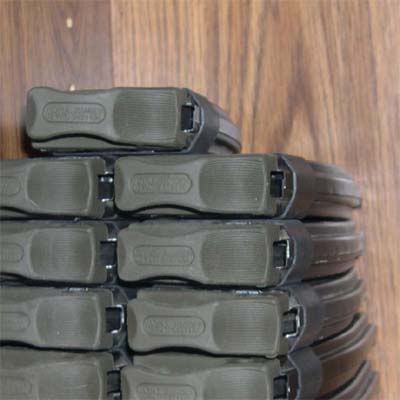 Dump Pouch -
Dump Pouch -I consider a dump pouch a necessity. I use mine to stow empty magazines until I can replenish them and replace them into my stockpile of fresh magazines. A dump pouch can also be used as a miscellaneous storage pouch for whatever else you might be required to carry in impromptu conditions.
If I need to reload and its very quick paced, I'll let the magazine hit the ground. I have Magpul Ranger Plates on my mags and I think they provide enough of a cushion against hard surfaces to allow me to let the magazine fall five feet to the ground. If theres some distance between the target and me, theres some cover, and its a bit slower paced, I'll take the extra time to reach around and place my magazine into my dump pouch.
I carry my dump pouch at the seven to eight o'clock position, attached to the rear waist strap of my chest rig. It is out of the way of my other gear, is in a good position to receive magazines from my left hand, and is not obstructed by my hydration carrier. Putting it at the six o'clock position would make it ambidextrous, but the position of my hydration carrier does not allow for this. I haven't found this to be a problem yet.
My preference is the CSM Gear Dump Pouch. Its larger than most, but thats why I like it. It has the capability to cinch down the opening, but I typically run it all the way open. I've not lost a mag, even when its very full and I'm moving around a lot. I've had two other dump pouches - A Tactical Tailor Dump Pouch and a Recce Gear dump pouch, both of which were basically large boxes with openings on the top. They had overlapping areas of elastic to provide a "one way" entrance into the pouch. I think this just made it slower and more difficult to use.
My dump pouch plays a large part in my magazine management strategy that I discussed earlier.
Pistols -I don't carry a pistol. I used to, but I found that I almost never used it. I've never experienced an AEG malfunction that wasn't related to the selector being somehow screwed up or the electrical system being messed up. If an AEG has a malfunction that puts it out of the fight, its likely a catastrophic failure that can't be fixed during the game. A pistol would allow you to stay in the fight for a while longer, but you're still going to have to go back to the cars to get a new AEG.
Switching to a pistol is probably faster than reloading a primary magazine for most people, but my experience says that most airsoft exchanges take place at a distance where a pistol would not be accurate enough to kill the enemy with. Cover can usually be found to reload your primary weapon and if you're not surrounded by your friends with long guns to back you up, then you're doing it wrong.
Those reasons are why I don't carry one. I also don't have to carry the extra weight of a pistol and magazines. I also don't have to configure my equipment to carry extra pistol mags.
-----
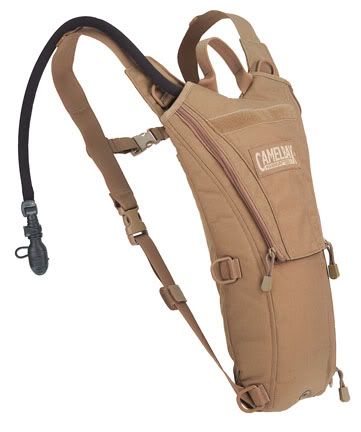 Hydration -
Hydration -Water is heavy. I'd say my 3 liters of water is over 50% of the weight I carry.
The rule of thumb for water intake during heavy activity is 1 liter per hour. Therefore, 3 liters means 3 hours sustainment, which is about what most airsoft games tend to be, if not a bit shorter. So I think 3 liters of water is perfect for most uses.
Ganef has several great designs that incorporate a hydration system into the rig and have it all one piece. I've gone back and forth between having a separate hydration carrier and an integrated one. Right now, I use a separate Camelbak from my rig. Maybe that will change in the future.
-----
 Communications -
Communications -I believe that everyone needs to have a radio. I think that every squad member should be able to tell anyone else exactly whats going on at any given time. Everyone should basically know where everyone is and everyone should never, ever get lost because they were out of contact with their squad.
At Lion Claws 5, being a fireteam leader, I had my radio on the squad channel most of the time. Once or twice, when my squad leader was dead, I had to switch to the platoon channel to talk to the Platoon Leader. It sucked having to take the radio out of the pouch and divert my attention to it instead of looking around and paying attention to my surroundings like I should have been. At Lion claws 6, I did have another radio, and it worked great having two separat radios for the squad net and the platoon net.
Having a Push to talk button that is not on the radio itself, I can position a radio somewhere not super easy to access. I have one of mine on the far left of my rig, out of the way. It is low enough that the antenna doesn't poke me in the armpit. It is still in a position where I can adjust the volume if need be, though. The other radio I carry is directly opposite the first, on my right side. Neither seem overly intrusive to me.
Communications equipment is a hard thing to peg down. There are so many different options available and so much if it is tied to your own preferences, all I really have to say about it is that you should find what works for you at your price point. After seeing many people purchase inexpensive and sometimes not so inexpensive "low end" headsets, throat mics, and the like, I decided early on that I wasn't going to waste my time and money going through several lesser setups to find what I'd like. I did some research and purchased a higher end headset. It was expensive, but the payoff is that it has worked flawlessly across the almost 3 years I've had it now, and I don't suspect it will fail me anytime soon.
-----
At the end of the day, we're all still just playing airball, so I'm not trying to imply or pretend that I'm some high speed guy. One of the kicks I get from airsoft is what I've been talking about here. The guns, the gear, the friends, the environments, and the mechanics of it all make me happy.
All of this didn't happen overnight. I've been playing airsoft for almost 5 1/2 years now, and only recently did I start doing half this stuff I just wrote down. You have to take your own experience into consideration when determining what will work best for you.
I hope this encourages you to consider your setup and make whatever refinements you deem necessary.
And remember, this is A way, not THE way.
-----------
Added 17 Feb 08 -
My "old" gear -

Chuckwalla utility pouch, 4x Dual M4 mag pouches, radio pouch, & dump pouch.
I've actually had most of my "new" stuff for almost a year now, but its been quite a while since I took any photos of it.
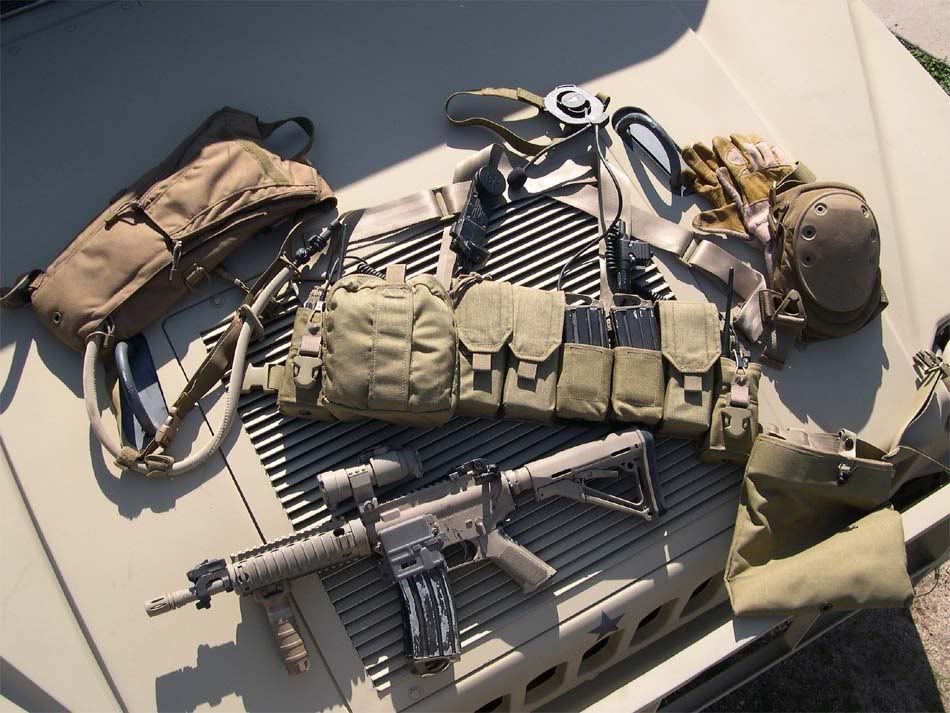
The biggest changes I've made is to use open top kydex magazine pouches and two radios.
Although its difficult to see at all, there is a modular chest rig underneath all the pouches. It is very straightforward. The body of the rig is mesh for breathability and has no map pockets or anything, because I didn't want any of that. I like the 2" unpadded seatbelt straps because they are simple and cooperate well with my camelbak sitting over them.
A photo of my old rig that was underneath the pouches in the first picture. I don't have a photo of the new one, but this is similar in its simplicity. -
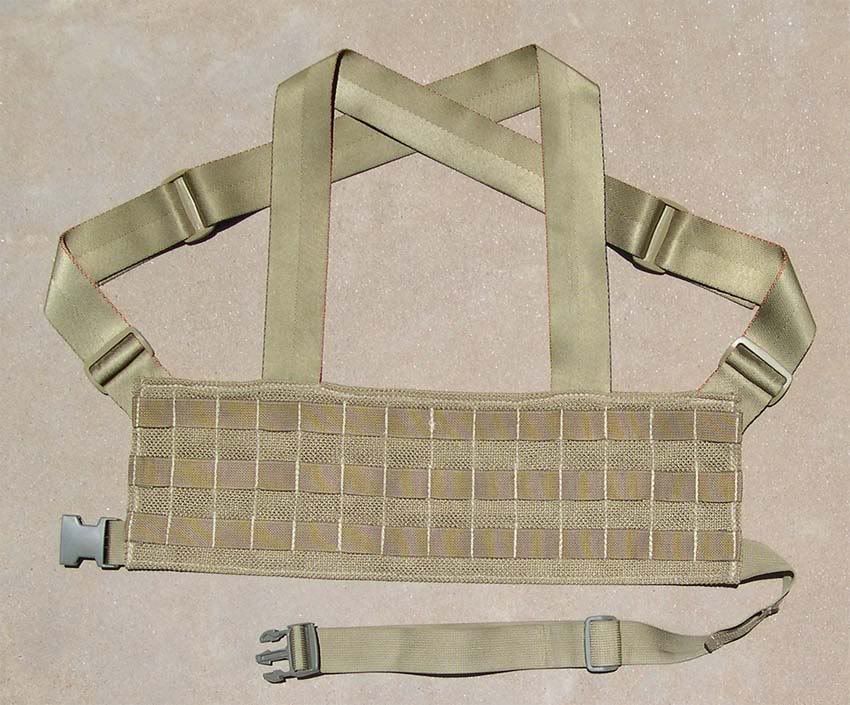
Back to the new stuff -
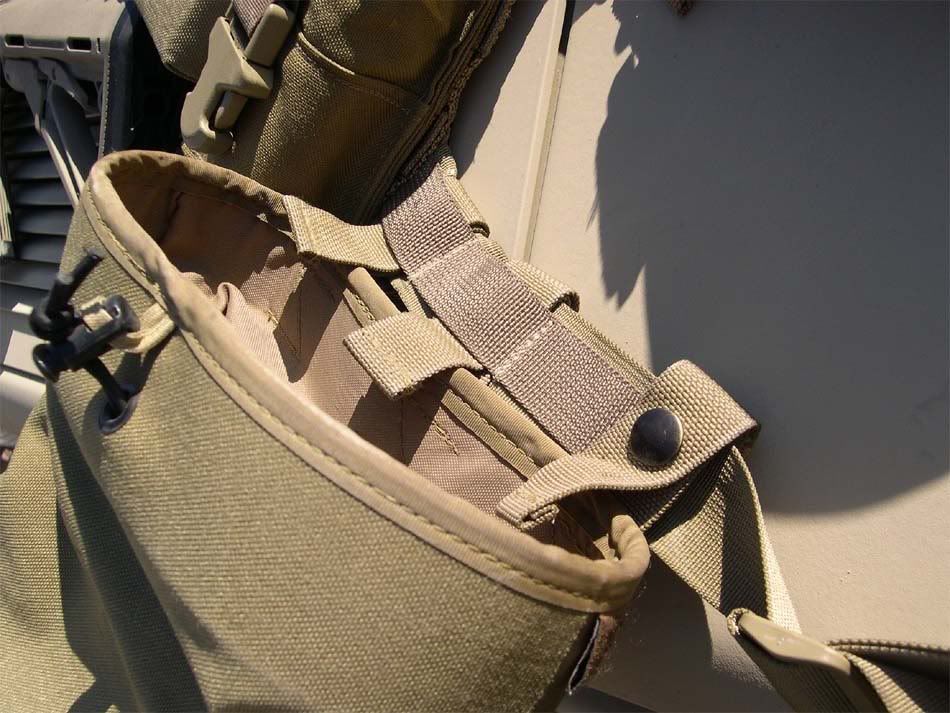
Detail here of how the dump pouch is secured to the waist strap so that it doesn't shift on the around. I run my dump pouch on my left side, because I'm right handed, shoot right handed, and drop my mags with my left hand. Also, because of this, I have the buckle positioned on the right side so that the dump pouch can be as far "forward" as possible.
I have, upon occasion, considered moving my dump pouch to the center of the waist strap to position it so that I could drop magazines into it with my right hand if I was shooting left handed, but as with a lot of things, its kind of robbing Peter to pay Paul - My regular usage of the pouch would suffer just to allow a slight advantage to a situation I'm rarely in. (Reloading with my right hand) Not to say it doesn't happen, but I can always ditch the mags on the ground. Not to mention the fact that my Camelbak might stick into it a bit, reducing the size of the mouth of the pouch.
Lately I find myself dropping magazines onto the ground much more often than putting them into my dump pouch, (At least, in the immediate moment) but I still want to have one on me, as I use it for other general utility options.

Radio pouch. I use two ICOM F4S radios. They are positioned on either end of the chest rig. I don't use the other radio all the time, typically only at large events with multiple radio nets where I need two radios. (depending on my position) I have some tape around the shock cord to hold the cord over the plug on top of the radio to keep it secure.
As a point of interest, the radio pictured is sitting backwards in the pouch, with the face pointed towards me when I wear it. This is so that the antenna is inboard and doesn't poke me in the arm pit. My other radio sits "correctly" in its pouch because the antenna is already inboard.
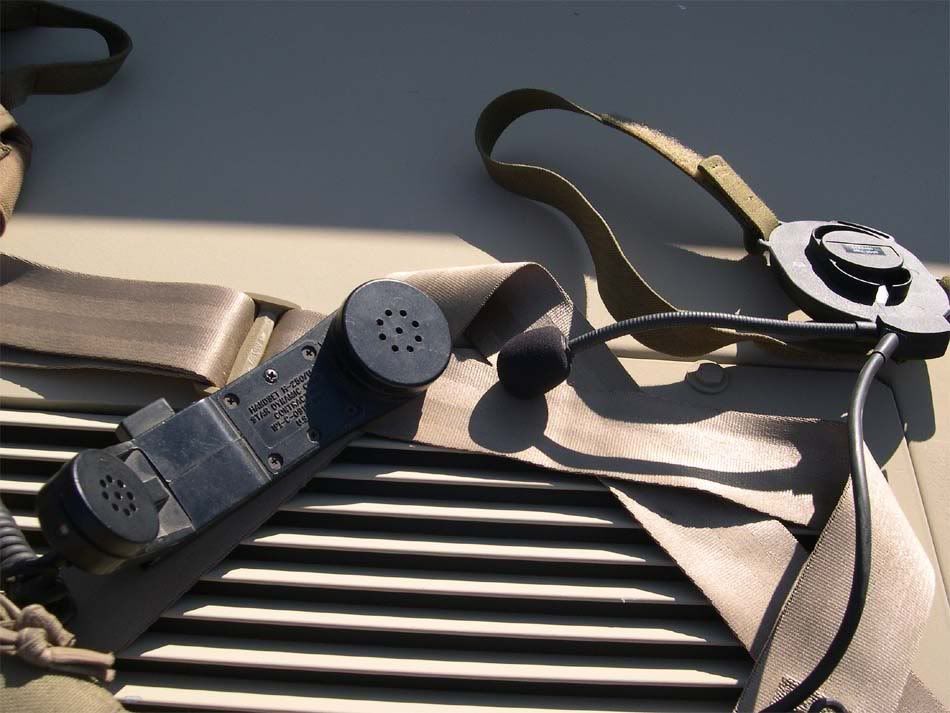
The radio on my left side is my primary radio and is connected to my LITE II Headset, which is shown here on the right. This headset is similar to the Bowman PRR headsets and the basis of the Cavalvy Elite I/II headsets.
The item on the left is a H250 handset. More on that below.

Here you can see my PTT assembly. There is a disconnect between the PTT and the headset. I got this setup, because I wanted to be able to change out headsets if I wanted, or attach two radios to one headset. (Something I've since decided against)
The PTT bites pretty hard into whatever you put it onto, so I've had a strip of 1" webbing added to the shoulder strap so that it doesn't tear up the strap underneath. I'm considering rearranging how I have this setup, as I'm worried that it will interfere with my open top magazine pouches below. So far, no difficulties, but it seems to me like it might be asking for trouble.
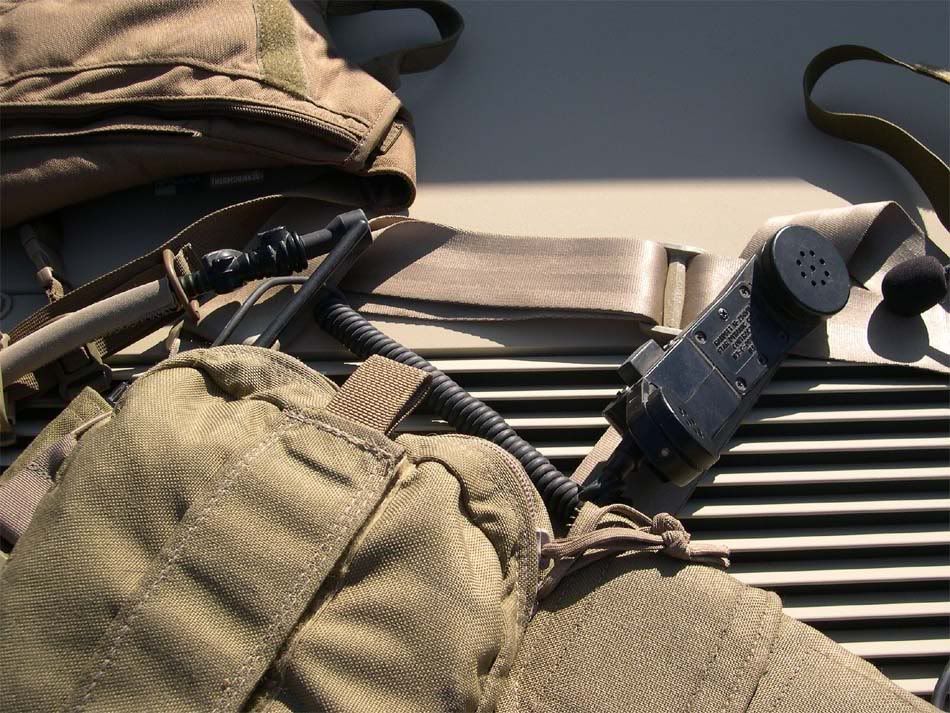
Another shot of the H250 handset. You can follow the cord to my 2nd radio on the end of my rig.
At first, I thought the H250 handset was kinda gimmicky, but after using it, a really cool thing happened. Having an aural and physical separation between the speakers for my radios improves my ability to use them tremendously. With one radio and speaker being on the left and one being on the right, it is much easier to discern between them and seperate whats going on mentally, even if they're both receiving chatter at the same time.
I wanted to hook two radios to my headset, but now having seen other people with this setup, I don't think I'd like it. Both radios talking into one ear at the same time seems like a mess to me.
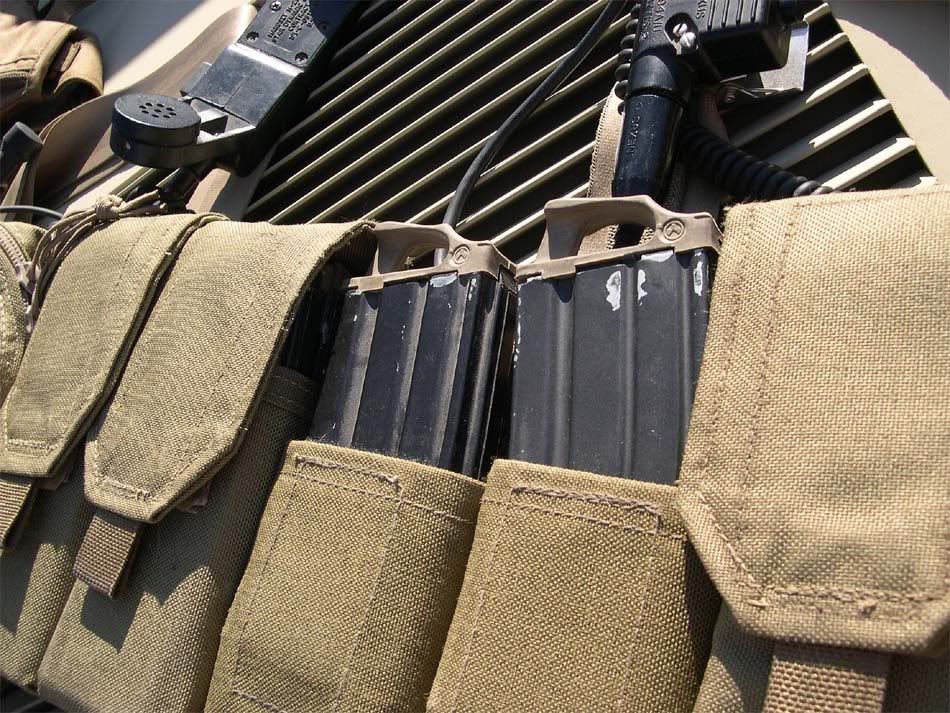
Open top kydex lined single M4 magazine pouches. I carry 8 total mags on my rig and 2 reside in these pouches.
Drawing magazines from these pouches, for me, is much faster than drawing a mag from my other pouches. Ideally, when I reload my weapon, I grab a magazine from one of these pouches and slap it into the gun. If I've got time, a magazine from one of the other pouches is placed into the open top mag pouch to make it ready again.
These pouches have a kydex liner to make them stiff enough to hold their shape without a magazine in them, as well as provide enough retention to hold the magazine in place under activity. Some loop velcro inside lets the magazines slide in and out. The velcro is merely the correct texture to provide friction and a stand off against the kydex - There is not matching velcro on the magazines. I really like these pouches. The retention strength is enough to hold the mag in upside down, while running, etc without being so much that it is difficult or slow to extract a mag when you need it.
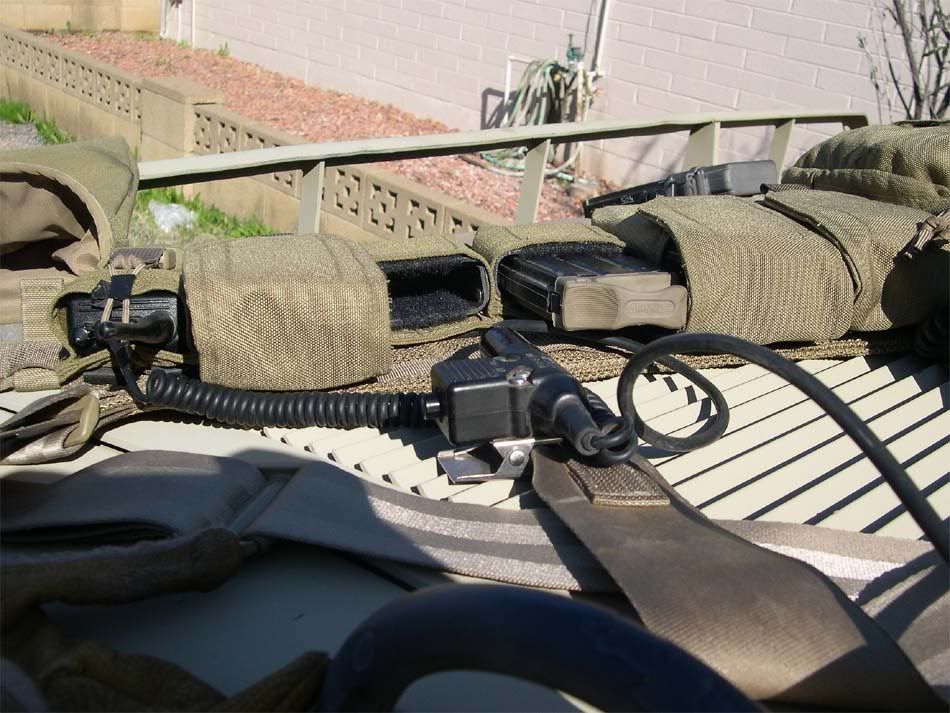
Here you can see down into one of the pouches with no magazine in it. You can see the kydex and velcro liner as well.
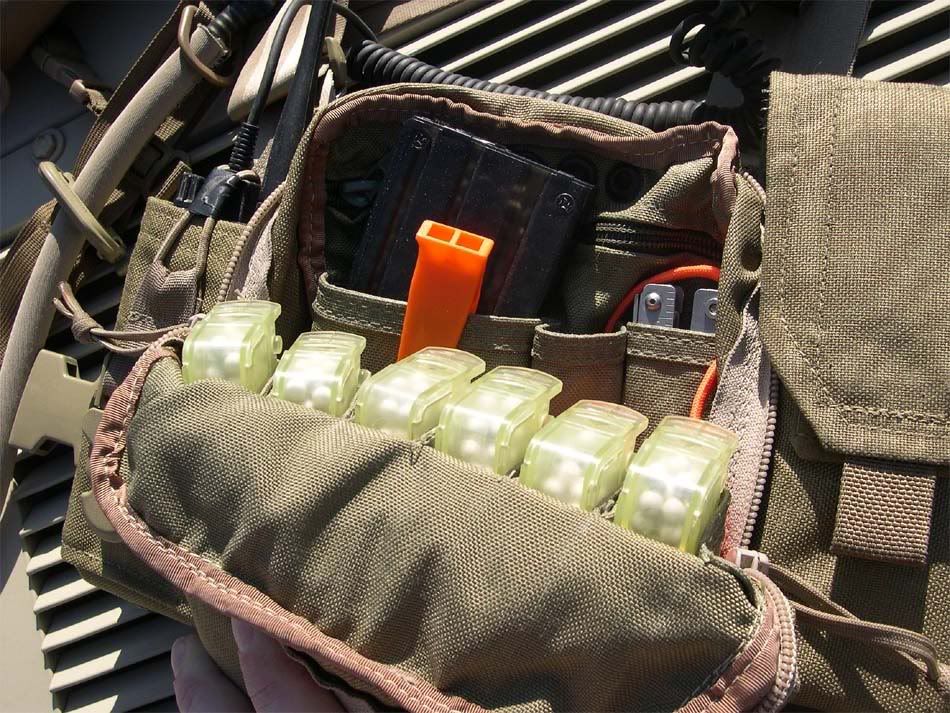
Chuckwalla utility pouch. On the front wall of it, you can see the six pistol mag loaders. Each one has an individual slot to go into. On the back wall, you can see the XL BB loader, multitool, and whistle. The back wall also has a zippered pouch for stuff I don't want to lose and some grommets for tie downs.
What you can't see (I didn't think to take a photo of the bottom) is the spare radio batteries, GPS batteries, goggle fan batteries, compass, and whatever other stuff I have during a game - like a bag of BBs, granola bars, etc.
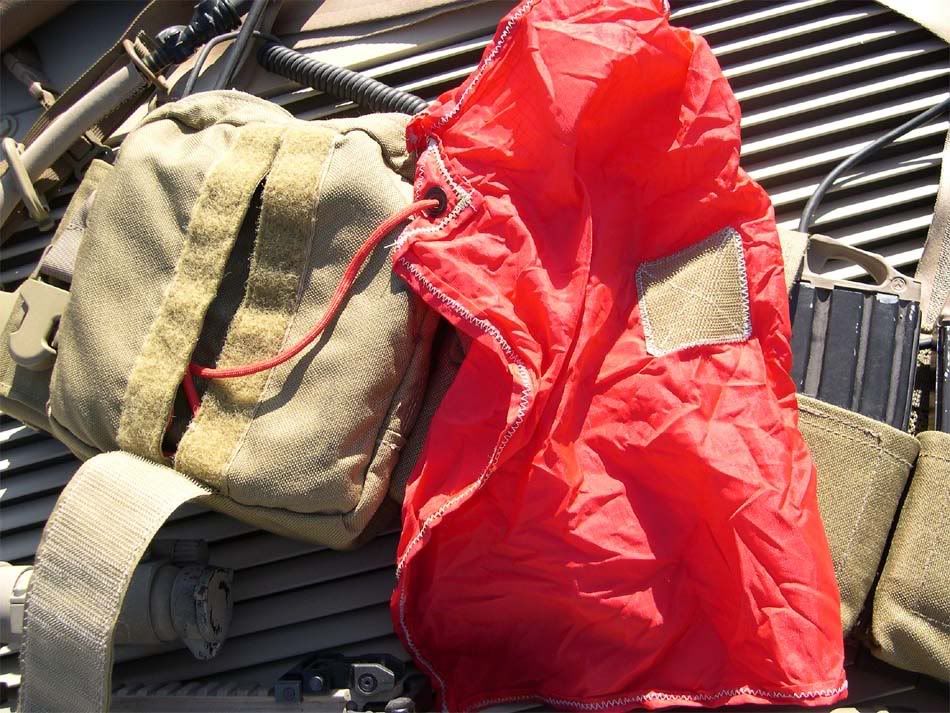
Death rag. Typically I have a square of loop velcro on my headgear and so my death rag stays where I put it. I also put a lanyard on it so I definately won't lose it. The death rag is lightweight and folds up nicely so it fits inside the chuckwalla.
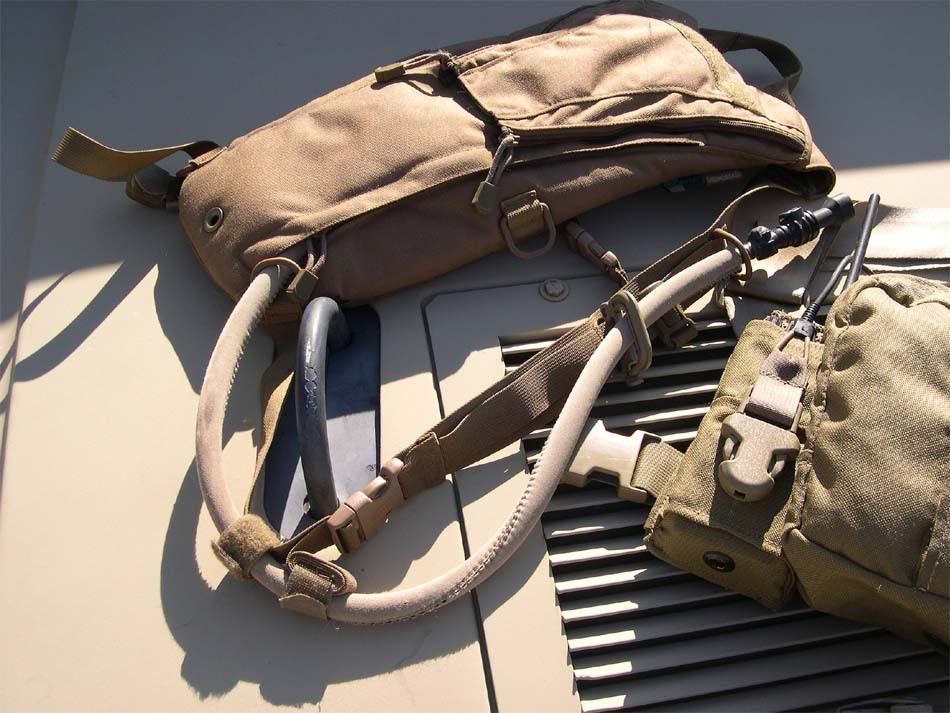
Here you can see my hydration carrier. It is a Camelbak Thermobak 3 liter. I run my hydration carrier separate from the rest of my gear. One of the things I like the best about the Thermobak is that it has a zipper running along the right side. This zipper allows me to have the drink tube exit the carrier on the bottom, so I can run the drink tube up under my right arm, which is how I prefer it.
The Thermobak is pretty simple and carries only water. I've contemplated switching to a Camelbak Ambush (or similar) to gain a pouch on the back for additional storage, but typically I don't find myself missing any said storage.
I run my hydration on the right and my commo on the left. Initially, my rationale was that I didn't want to get my commo items wet, but using nice stuff, it can take it. So realistically, the reason is more along the lines of the fact that my PTT is more in the way of shouldering my weapon than the drink tube is, so I run the drink tube on the right.
Hope this was informative.
-----------
Added 11 Feb 09 -
I took some photos, so I figured I'd do a small write up -
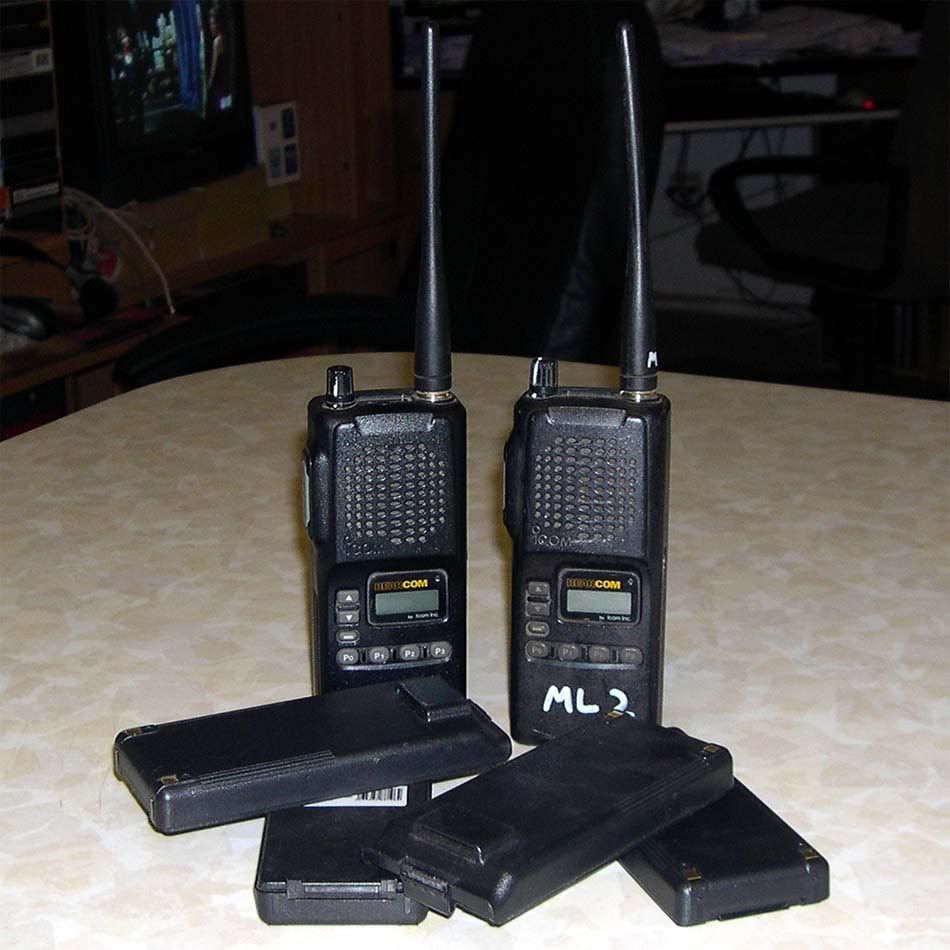 2x ICOM F4S and batteries
2x ICOM F4S and batteriesThe ICOM F4S is a 4 Watt UHF (440-470MHz) radio. I have 3 batteries for each radio although each battery seems to last all day for the most part. They are 9.6v 1450mah NiMh batteries. The battery attaches onto the radio and is about 50% of the total size and about 75% of the total weight. The batteries come with detachable belt clips, but I don't use them for the most part, as the pouches on my gear a sized for them without clips.
 TEA LITE II Headset with lower cordset and ICOM F4S Radio
TEA LITE II Headset with lower cordset and ICOM F4S RadioThe TEA LITE II Headset is similar to the Bowman PRR headset and the Cavalvy Elite/Elite II. The base headset is manufactured by Davies and assembled by Television Equipment Associates. (TEA) The headset downlead ends with a U-93 plug which goes into a lower cordset made up of a U-94 push-to-talk, (PTT) some coiled cabling, and terminates in a standard ICOM plug. There is a clip on the PTT to attach it to your gear.
One of the reasons that I wanted the LITE II over a comparable TCI offering is the option of having the U-93/U-94 junction inline with the radio. I wanted to be able to remove the headset and leave the lower cordset "threaded" into my gear. There is an earpiece cover for loud environments, but I've found it to be almost useless for me. I have removed the top strap on the headset, as I've found that it does very little in terms of securing it to my head. This headset gets the most amount of usage by me.
At one point, I wanted to get a lower cordset/PTT that was capable of having input from and output to two separate radios. The issue with this is that there is only one speaker on only one side of your head with this headset. This leads me to the next item -
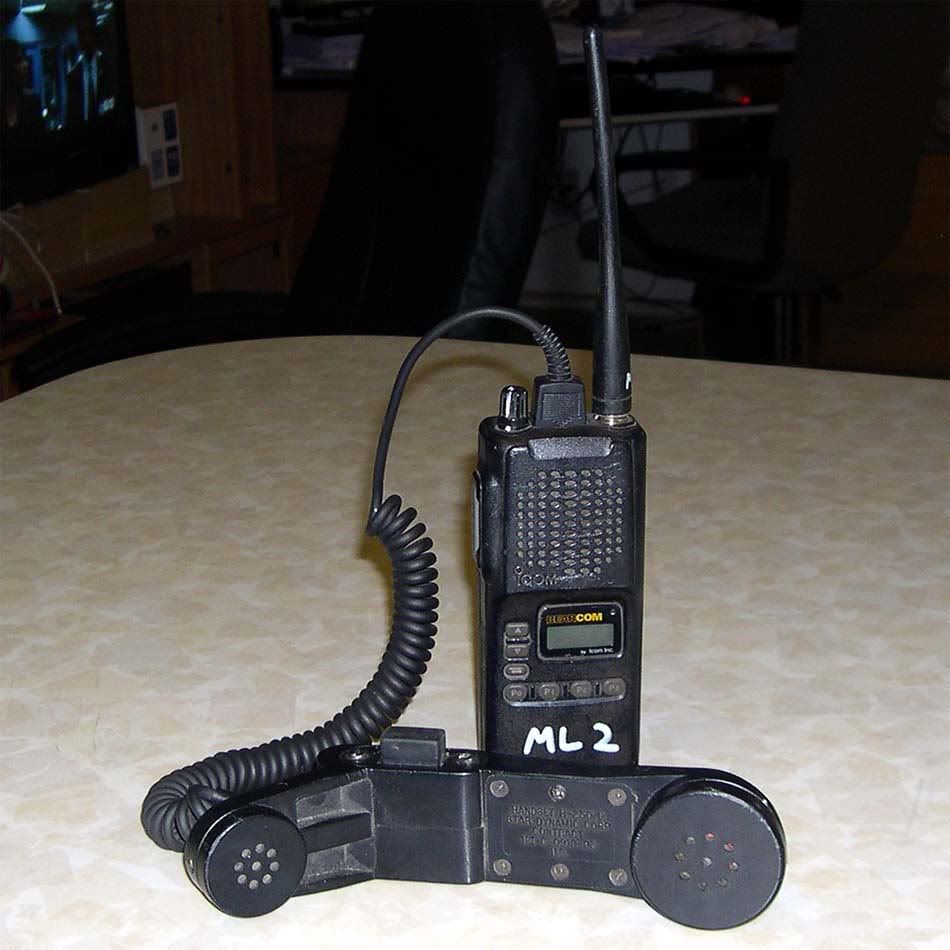 H-250 Handset and ICOM F4S Radio
H-250 Handset and ICOM F4S RadioThe H-250 is a handset that has a speaker, microphone, and push-to-talk button built into it. They usually come terminated in a U-229 connector, but this one has a standard ICOM two pin plug. There is a clip on the back of the handset to attach it to your gear.
I use this handset when I want to use my LITE II headset and two radios. I usually clip the H-250 to my right shoulder. This simple aural separation does a wonderful job of letting you keep which radio is receiving straight. The human brain is very good at distinguishing directional noises, and having a physical separation of radio output to left and right ears allows you to keep track of each. Its not easy, but it is possible to listen output from both radios at the same time. This setup has worked very well for me, and while I haven't ever had a dual radio setup outputting into one ear, I've seen others do it with poor results.
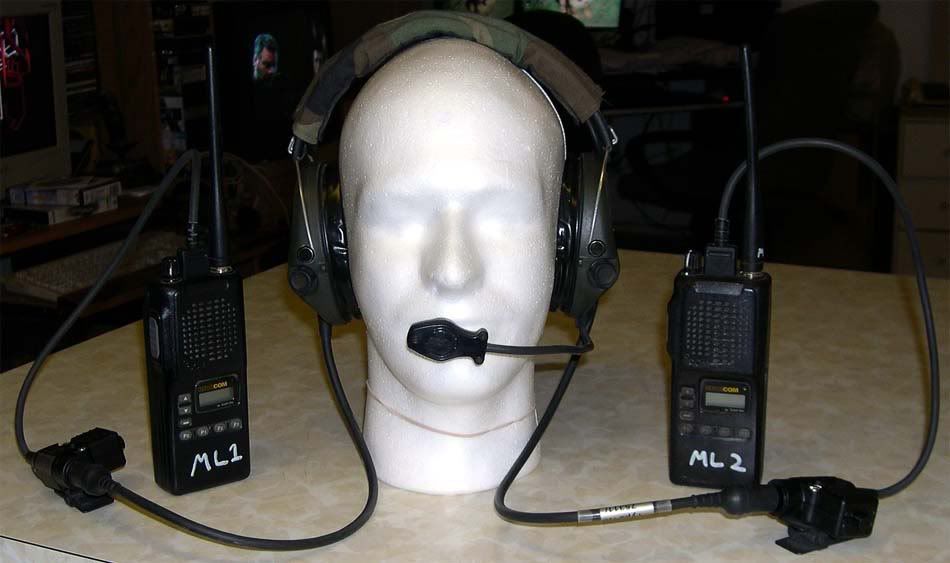 MSA Ranger MICH Communication Headset with 2x U-94 PTTs terminating in ICOM connectors and 2x ICOM F4S Radios
MSA Ranger MICH Communication Headset with 2x U-94 PTTs terminating in ICOM connectors and 2x ICOM F4S RadiosThe MSA Ranger MICH Communication Headset is built around a Sordin Supreme Pro hearing protection headset. It has a microphone on a boom to pick up what you're transmitting and 2 cables to plug into whatever PTT that you are using. In this case, I'm using two MSA manufactured U-94 PTTs with standard ICOM connectors on the other end which plug into the radios. Each ear cup has two speakers, one lets you hear external noise while suppressing loud noises (such as gunfire, explosions, etc) and the other speaker handles the radio input. The radio plugged into the right downlead outputs into the right earcup speaker and the left downlead into the left earcup speaker.
I have the gel seal earcups which make a tremendous difference in terms of the comfort of the headset, especially over a long period of time.
The Ranger MICH Comm headset was something I'd wanted for a long time without any real reason for having one. I finally picked one up late last year for much less than I thought they'd go for. Hooray ebay. Finding the ICOM PTTs was the real trick.


Here is a photo (from a different set) of the chest rig I use and how I'd have the radios, LITE II headset, and H-250 handset setup. You can see the ICOM radios in their pouches on either end of the rig, and the H-250 going to the right (as worn) radio. The headset is hooked to the other radio.